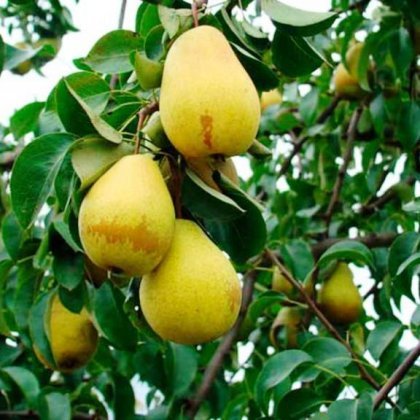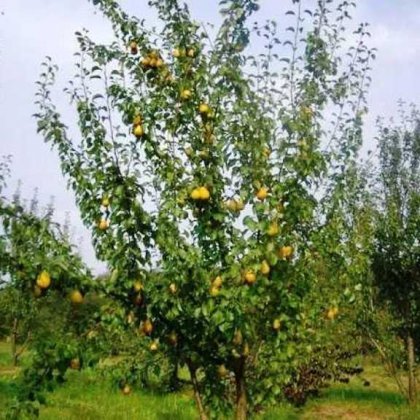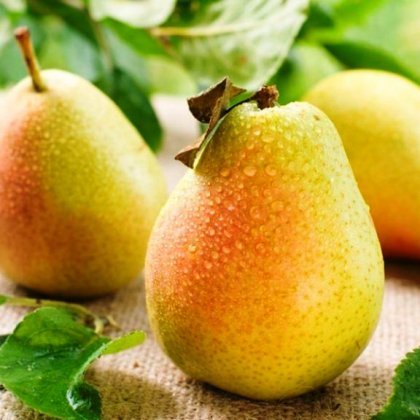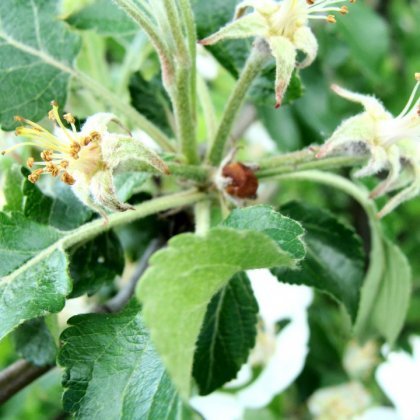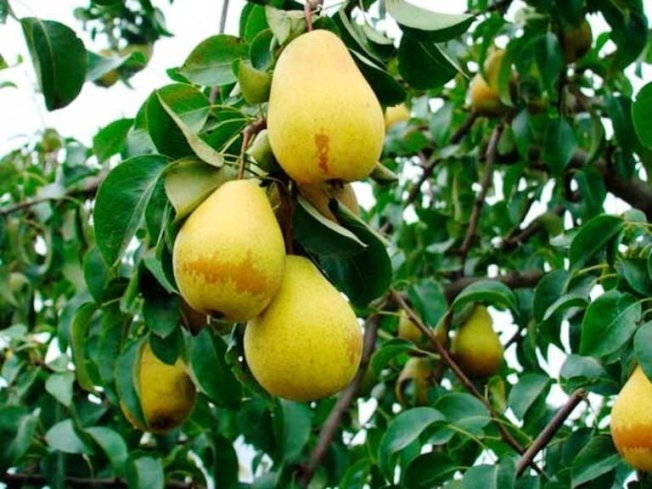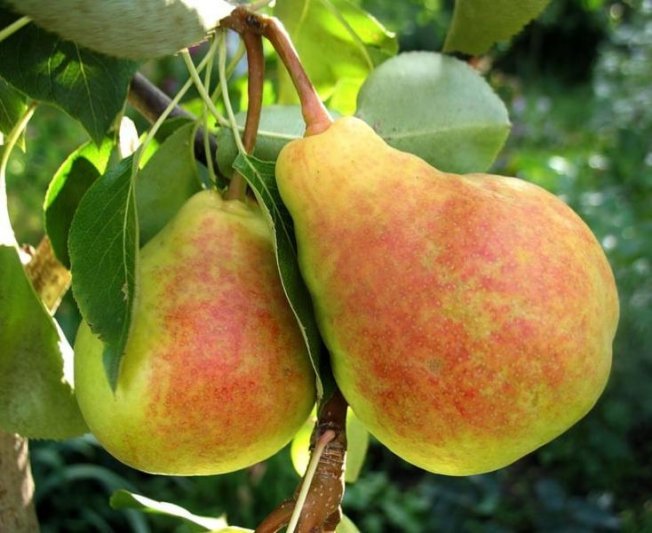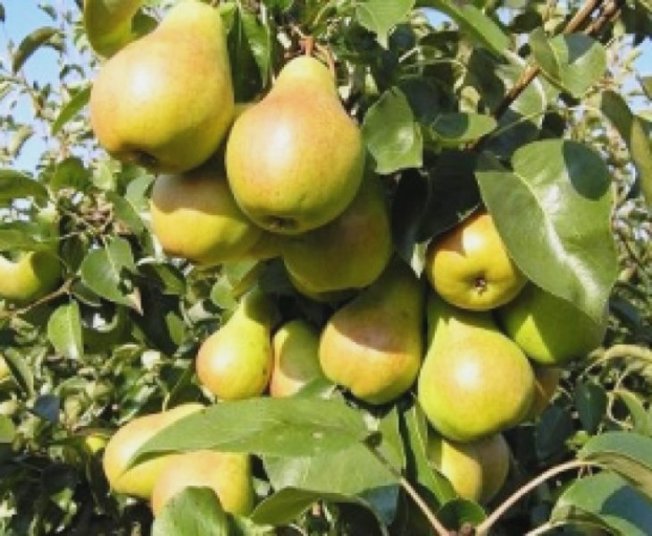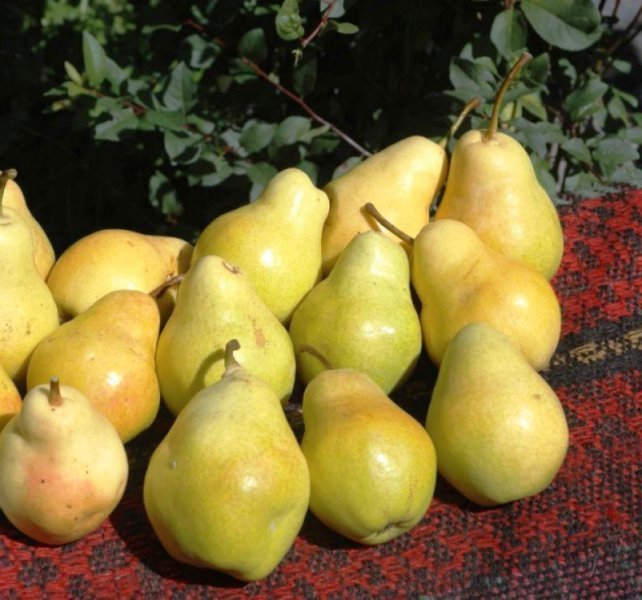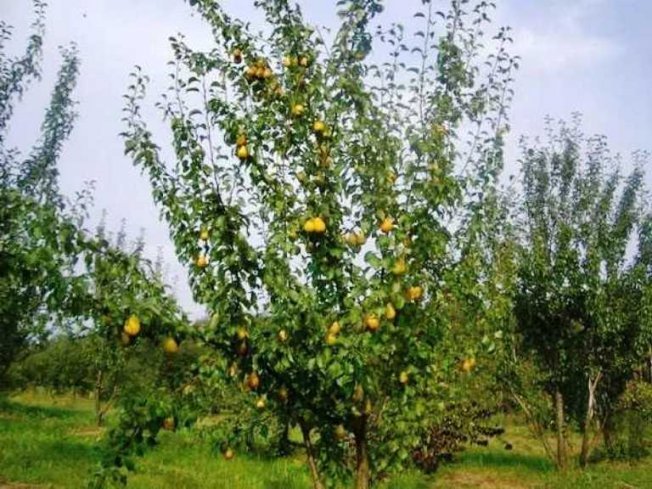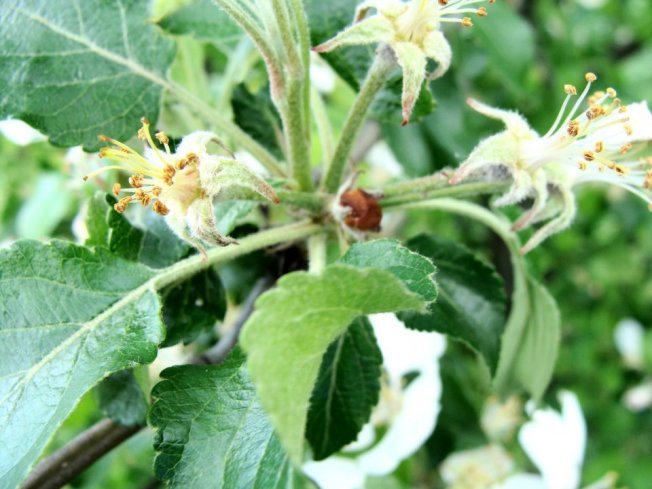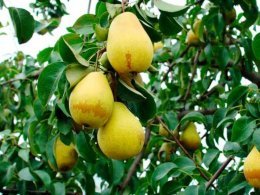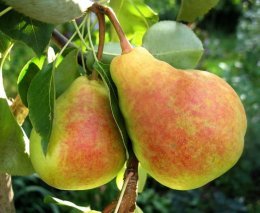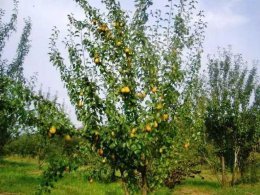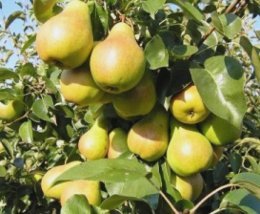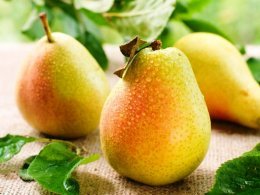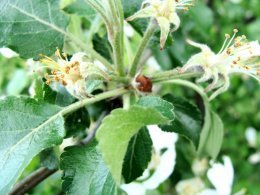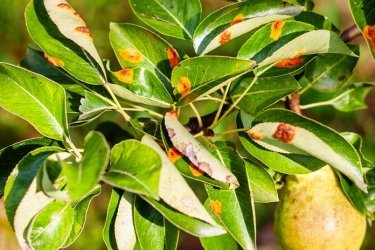Lada is an early-ripening, high-yielding, frost-resistant pear variety
Lada
Lada
No
Early ripening

Lada is a high-yielding pear variety that is very popular in many regions of Russia. Gardeners are attracted by its resistance to the most common diseases and excellent frost resistance.
History of the variety
Lada is a pear variety that does not have a long history. It was bred by Timiryazevka scientists in 1979, during breeding work on the Lesnaya Krasavitsa and Olga varieties.
From these varieties Lada acquired its best properties:
- high taste qualities;
- ability to survive in harsh weather conditions;
- immunity to diseases, in particular scab.
In 1993, the variety was included in the State Register and recommended for cultivation in the East Siberian, Central and Central Black Earth, Middle Volga and Northwestern regions.
Description of the tree
For greater clarity, let’s list the main characteristics of the tree in Table 1.
| Options | Features of the variety |
| Crown | A young tree is funnel-shaped, but with age it changes to a pyramidal shape. |
| Dimensions | The tree is medium-sized, height about 3 m. |
| Bark | Dark gray on the trunk, gray on the skeletal branches, light brown on the shoots |
| Kidneys | Cone-shaped, slightly deflected, color - brown |
| Leaves | The surface is smooth, dark green, medium in size, elongated oval in shape, medium in thickness, with serrated serrations along the edge. Leaf petioles are medium length. |
| Type of fruiting | Mixed |
Description of flowers and fruits
Pear flowers:
- snow-white;
- medium size;
- cup-shaped.
Corymbose inflorescences consist of 5-7 flowers.
The fruits have the following parameters:
- The sizes are medium, up to 110 g, the shape is wide-ribbed, pear-shaped.
- The cover blush is red and can occupy up to half the surface.
- Rustyness is observed only near the legs, subcutaneous points are almost invisible.
- The view is quite attractive.
- There are no more than 5 seeds, they are small and brown in color.
The structure of the fruit pulp of the Lada variety pear is fine-grained, medium density, slightly yellowish in color. The taste is sweet with noticeable sourness. The aroma is weak.
According to the tasting assessment, the fruits have from 4.1 to 4.4 points out of 5 possible.
Characteristics of the variety
An adult tree can withstand frosts down to - 30 C. Quite hardy, it still needs watering during periods of severe drought.
The tree is resistant to scab. The tree begins to bear fruit quickly, 3-4 years after planting.
The Lada pear variety is early ripening and ripens in the second half of August.
The yield, considering the size of the plant, is high; up to 50 kg of pears can be harvested from one tree.
Fruits regularly, the fruits do not fall off the tree. Their shelf life. Even if harvested in an unripe form, it is not large; in ideal conditions and at a temperature of about +1 C they can be stored for about 2 months.
The variety is universal, the fruits can be eaten fresh, prepared in the form of jams, compotes, preserves.
The fruits are not intended for transportation.
Lada pear is an early summer variety; its fruits do not withstand long-term storage.
Let's watch an interesting video about the Lada pear:
Advantages and disadvantages of Lada pear
Among the advantages of the variety it is worth highlighting:
- scropedity;
- winter hardiness;
- high productivity;
- early ripeness;
- good taste;
- attractive appearance of fruits;
- immunity to scab.
Disadvantages of the variety:
- fruits do not last long and are unsuitable for transportation;
- no immunity to brown spot;
- increased sugar content attracts wasps;
- the plant requires pollinators.
How to choose a place to plant a pear
The place for planting the pear must meet certain requirements:
- be well heated by the sun and well illuminated by it, it is best to choose in the southern or southwestern part of the site;
- during the period of seedling growth, it is necessary to protect the plant from direct sunlight at noon;
- in winter, the plant must be protected from the north wind; in summer, the tree crown must be ventilated;
- groundwater should not lie at a depth of less than 2 m from the ground surface, otherwise it will be necessary to organize a drainage system on the site, or plant a plant on an artificial hill.
The ideal soil for growing pears is chernozems, chestnut soils and loams with neutral acidity. When planting on heavy clay soils, river sand and peat are added to the planting hole.
When and how to plant a seedling
In areas with a temperate climate, it is better to plant young pears in the fall, about a month before the expected start of frost, so that the tree has time to take root. If planting is planned in the spring, then it must be done before the sap begins to flow.
It is recommended to plant trees at the age of 1-2 years. If the seedling has a closed root system, then you can buy an older tree.
The planting pit is prepared in advance; its dimensions are: 1m x 1m x 0.7m (depth).
The excavated soil is enriched with:
- 600g ash;
- 200g ammophoska;
- 10 kg of rotted manure;
- 700g dolomite flour.
Fill the dug hole with enriched soil and water well. It is not recommended to place fresh manure in the pit.
When planting a seedling, a hole is made whose dimensions correspond to the dimensions of the roots. The roots of the seedling are carefully straightened. A support is installed next to its trunk. Next, the hole is filled with soil, and the seedling is tied to a support.
It is necessary to ensure that the root collar of the tree is 5-6 cm above the ground level.
After forming the watering circle, the seedling is watered with 2-3 buckets of water. After moisture is absorbed, the soil is mulched.
Let's watch an interesting video:
Pollinators for pear
Pollinators for the Lada variety are required because... it is only partially self-fertile.
The choice of pollinating varieties is quite wide, these can be:
- popular Severyanka;
- Chizhovskaya;
- Otradnenskaya or Moskvichka;
- Rogneda;
- Skorospelka and Cosmic.
If the plot is small and it is not possible to plant two pear trees on it, then you can go the tricky route and plant a variety suitable for pollination into the crown.
Care instructions
Lada is a pear variety that should be considered moisture-loving, so you will need to constantly keep the soil in the tree trunk moist. This moment is especially important in the first years of the tree’s life. Water is applied along the perimeter of the crown; it is advisable to carry out sprinkling.
It is recommended to clear the tree trunk circle of weeds, periodically loosen it or mulch it.
If all recommended fertilizers are applied to the planting hole, then for the next two years you can do without fertilizing. But with the beginning of fruiting they will definitely be needed.
In the spring, the nitrogen content of the substance is added, you can use 90 g of urea dissolved in 7 liters of water, fertilizing is done after abundant watering of the tree. You can also add a diluted infusion of chicken manure.
At the end of flowering, the tree is topped with a solution of nitroammophoska, 50 g of dry matter per 10 liters of water.
To determine the need for summer feeding, the plant is examined; feeding is carried out if a lack of minerals is detected.
When leaves curl, their growth stops, or brown spots appear, phosphorus-potassium fertilizers are applied by spraying the crown. After 2 weeks, fertilizing with organic matter is carried out; for this, a solution of slurry or mullein is added to the tree trunk circle when watering.
After autumn leaf fall, the pear is watered with a solution of mineral fertilizers: 35 g of superphosphate and 15 g of potassium chloride are added to 10 liters of water. When digging 1 sq.m. area add 140 g of ash.
Trimming
The crown of the Lada pear variety is formed over the course of 4 years; when grown in a temperate climate, it is recommended to give it a spread-tiered shape.
Each year, one tier is formed by shortening the branches and removing excess shoots. The central conductor is also trimmed; it should be 30 cm higher than the skeletal branches.
During annual formative pruning, all shoots formed between the tiers are cut off.
The fruit-bearing tree is thinned out, and sanitary pruning must be carried out. The number of branches cut should not exceed 30% of their total volume.
The cuts must be treated with garden varnish to prevent infection.
Organization of wintering
The Lada pear variety is frost-resistant, but in the first years of life the seedling requires insulation of the trunk, and it is also recommended to mulch the soil in the tree trunk circle.
An adult tree does not need special insulation. But, in order to protect the trunk from rodents, you can wrap it in fine mesh for the winter or tie it with spruce branches.
It is not recommended to use plastic film or roofing felt for such purposes.
Common diseases
Lada is resistant to some diseases that affect pome crops, however, under unfavorable circumstances, it can also suffer from various ailments, so periodic inspection of the tree should be carried out. Preventive measures should not be abandoned.
We present in the table the most common pear diseases and indicate what treatment will help get rid of them.
| Name of the disease | Symptoms | How and with what to treat | Prevention |
| Brown spot | Small brown spots on the leaves, subsequent complete damage to the leaves and falling off | Before bud break, treatment with a 3% solution of Bordeaux mixture, Kuproxat, Meteor, Champion, and other copper-containing products | Cleaning and burning leaves, digging soil between rows and tree trunks |
| Moniliosis | It can manifest itself as rotting of fruits followed by mummification, or as monilial burn: browning of leaves and flowers | Treatment with solutions of Abiga-Pika, Horus, Bordeaux mixture | Cleaning and destroying affected fruits and leaves, digging up soil in the garden, protecting fruits from wasp attacks |
| Cytosporosis | Drying of bark, shoots and branches | Removing affected areas of branches, treating cut areas with a solution of nitrafen, copper sulfate, covering with garden pitch | Carrying out sanitary pruning, protection from frost damage and sunburn, keeping the tree trunk clean. |
Pests
The tree may also suffer from an infestation of insect pests.
The most common among them is the pear flower beetle. You can notice it during the flowering period of the tree: beetle eggs previously laid in the buds turn into larvae that actively eat the stamens, pistil and receptacle. The buds dry out completely. Young beetles feed on leaves.
You can prevent damage to the pear flower beetle:
- carefully maintaining the cleanliness of the tree trunk circle;
- spraying the crown before flowering with an infusion of tansy or chamomile.
If pests have already appeared, then the plants are sprayed: with Actellik - before flowering, with Metaphos - after.
It is also recommended to equip trees with catching belts.
The pear worm, or rather its larvae, infect the tips of the shoots and buds, leaves, and fruits.
Symptom of defeat:
- sticky coating on leaves;
- blackening and curling of the leaf blade;
- the leaves fall off and the fruits lose their presentation; their taste also deteriorates.
To combat the copperhead, use:
- Nitrophen - until the buds open;
- Iskra, Konfidor, Inta-Vir - before flowering;
- Agravertine, Iskra - after flowering.
The Lada pear variety is distinguished by its sweet, although not very large, fruits, with pulp that melts in your mouth. They are difficult to keep fresh, but they can be prepared in the form of jam.



